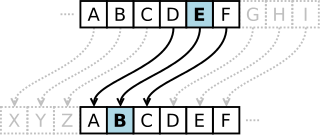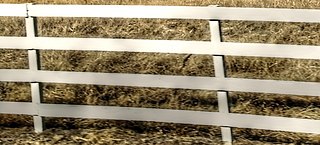Related Research Articles
In cryptography, a block cipher is a deterministic algorithm that operates on fixed-length groups of bits, called blocks. Block ciphers are the elementary building blocks of many cryptographic protocols. They are ubiquitous in the storage and exchange of data, where such data is secured and authenticated via encryption.
In cryptography, a substitution cipher is a method of encrypting in which units of plaintext are replaced with the ciphertext, in a defined manner, with the help of a key; the "units" may be single letters, pairs of letters, triplets of letters, mixtures of the above, and so forth. The receiver deciphers the text by performing the inverse substitution process to extract the original message.

In cryptography, a transposition cipher is a method of encryption which scrambles the positions of characters (transposition) without changing the characters themselves. Transposition ciphers reorder units of plaintext according to a regular system to produce a ciphertext which is a permutation of the plaintext. They differ from substitution ciphers, which do not change the position of units of plaintext but instead change the units themselves. Despite the difference between transposition and substitution operations, they are often combined, as in historical ciphers like the ADFGVX cipher or complex high-quality encryption methods like the modern Advanced Encryption Standard (AES).

In cryptography, a Caesar cipher, also known as Caesar's cipher, the shift cipher, Caesar's code, or Caesar shift, is one of the simplest and most widely known encryption techniques. It is a type of substitution cipher in which each letter in the plaintext is replaced by a letter some fixed number of positions down the alphabet. For example, with a left shift of 3, D would be replaced by A, E would become B, and so on. The method is named after Julius Caesar, who used it in his private correspondence.

The Vigenère cipher is a method of encrypting alphabetic text where each letter of the plaintext is encoded with a different Caesar cipher, whose increment is determined by the corresponding letter of another text, the key.

An autokey cipher is a cipher that incorporates the message into the key. The key is generated from the message in some automated fashion, sometimes by selecting certain letters from the text or, more commonly, by adding a short primer key to the front of the message.

In cryptography, the tabula recta is a square table of alphabets, each row of which is made by shifting the previous one to the left. The term was invented by the German author and monk Johannes Trithemius in 1508, and used in his Trithemius cipher.

In cryptanalysis, frequency analysis is the study of the frequency of letters or groups of letters in a ciphertext. The method is used as an aid to breaking classical ciphers.

The Playfair cipher or Playfair square or Wheatstone–Playfair cipher is a manual symmetric encryption technique and was the first literal digram substitution cipher. The scheme was invented in 1854 by Charles Wheatstone, but bears the name of Lord Playfair for promoting its use.

In cryptography, ciphertext or cyphertext is the result of encryption performed on plaintext using an algorithm, called a cipher. Ciphertext is also known as encrypted or encoded information because it contains a form of the original plaintext that is unreadable by a human or computer without the proper cipher to decrypt it. This process prevents the loss of sensitive information via hacking. Decryption, the inverse of encryption, is the process of turning ciphertext into readable plaintext. Ciphertext is not to be confused with codetext because the latter is a result of a code, not a cipher.
The affine cipher is a type of monoalphabetic substitution cipher, where each letter in an alphabet is mapped to its numeric equivalent, encrypted using a simple mathematical function, and converted back to a letter. The formula used means that each letter encrypts to one other letter, and back again, meaning the cipher is essentially a standard substitution cipher with a rule governing which letter goes to which. As such, it has the weaknesses of all substitution ciphers. Each letter is enciphered with the function (ax + b) mod 26, where b is the magnitude of the shift.
In cryptography, the ADFGVX cipher was a manually applied field cipher used by the Imperial German Army during World War I. It was used to transmit messages secretly using wireless telegraphy. ADFGVX was in fact an extension of an earlier cipher called ADFGX which was first used on 1 March 1918 on the German Western Front. ADFGVX was applied from 1 June 1918 on both the Western Front and Eastern Front.
In classical cryptography, the bifid cipher is a cipher which combines the Polybius square with transposition, and uses fractionation to achieve diffusion. It was invented around 1901 by Felix Delastelle.
In cryptography, a classical cipher is a type of cipher that was used historically but for the most part, has fallen into disuse. In contrast to modern cryptographic algorithms, most classical ciphers can be practically computed and solved by hand. However, they are also usually very simple to break with modern technology. The term includes the simple systems used since Greek and Roman times, the elaborate Renaissance ciphers, World War II cryptography such as the Enigma machine and beyond.
Probabilistic encryption is the use of randomness in an encryption algorithm, so that when encrypting the same message several times it will, in general, yield different ciphertexts. The term "probabilistic encryption" is typically used in reference to public key encryption algorithms; however various symmetric key encryption algorithms achieve a similar property, and stream ciphers such as Freestyle which are inherently random. To be semantically secure, that is, to hide even partial information about the plaintext, an encryption algorithm must be probabilistic.

In classical cryptography, the Hill cipher is a polygraphic substitution cipher based on linear algebra. Invented by Lester S. Hill in 1929, it was the first polygraphic cipher in which it was practical to operate on more than three symbols at once.

The rail fence cipher is a classical type of transposition cipher. It derives its name from the manner in which encryption is performed, in analogy to a fence built with horizontal rails.
The four-square cipher is a manual symmetric encryption technique. It was invented by the French cryptographer Felix Delastelle.
In the history of cryptography, a grille cipher was a technique for encrypting a plaintext by writing it onto a sheet of paper through a pierced sheet. The earliest known description is due to Jacopo Silvestri in 1526. His proposal was for a rectangular stencil allowing single letters, syllables, or words to be written, then later read, through its various apertures. The written fragments of the plaintext could be further disguised by filling the gaps between the fragments with anodyne words or letters. This variant is also an example of steganography, as are many of the grille ciphers.
The Aristocrat Cipher is a type of monoalphabetic substitution cipher in which plaintext is replaced with ciphertext and encoded into assorted letters, numbers, and symbols based on a keyword. The formatting of these ciphers generally includes a title, letter frequency, keyword indicators, and the encoder's nom de plume. The predecessor to these ciphers stems from the Caesar Cipher around 100. The Aristocrat Cipher also used a transposition of letters to encrypt a message.
References
- ↑ "TICOM I-20 Interrogation of SonderFuehrer Dr Fricke of OKW/CHI". sites.google.com. NSA. 28 June 1945. p. 2. Retrieved 29 August 2016.
- ↑ Traité élémentaire de cryptographie. 1902. pp. 80–81. Retrieved 7 December 2019.
- ↑ Friedman, William F. (1931). Advanced Military Cryptography (PDF). Chief Signal Officer. Retrieved 7 December 2019.
- ↑ Callimahos, Lambros D. (1965). "Collier's Encyclopedia" . Retrieved 7 December 2019.
- ↑ Machiavelli (Mccready, Warren Thomas) (1972). "The Twosquare Cipher". The Cryptogram (Nov-Dec 1972): 152–153.
- ↑ American Cryptogram Association. "Cipher Types" . Retrieved 7 December 2019.
- ↑ Currer-Briggs, Noel (1987). "Some of ultra's poor relations in Algeria, Tunisia, Sicily and Italy". Intelligence and National Security. 2 (2): 274–290. doi:10.1080/02684528708431890.
- ↑ WGBH Educational Foundation. "The Double Playfair Cipher". 2000.
- ↑ Noel Currer-Briggs. "Army Ultra's Poor Relations" a section in Francis Harry Hinsley, Alan Stripp. "Codebreakers: The Inside Story of Bletchley Park". 2001. p. 211
- ↑ Schick, Joseph S. (1987). "With the 849th SIS, 1942-45". Cryptologia. 11 (1): 29–39. doi:10.1080/0161-118791861767.
- ↑ David, Charles (1996). "A World War II German Army Field Cipher and how we broke it". Cryptologia. 20 (1): 55–76. doi:10.1080/0161-118791861767.
- ↑ Bowers, William Maxwell (1959). Digraphic substitution: the Playfair cipher, the four square cipher. American Cryptogram Association. p. 25.